Living on Automatic: How Emotional Conditioning Shapes Our Lives and Relationships
Autor Homer B. Martin MD, Christine B. L. Adams MD Cuvânt înainte de Mary E. Schwaben Limba Engleză Hardback – 2 aug 2018 – vârsta până la 17 ani
Preț: 241.40 lei
Preț vechi: 294.38 lei
-18% Nou
Puncte Express: 362
Preț estimativ în valută:
46.23€ • 47.63$ • 38.73£
46.23€ • 47.63$ • 38.73£
Carte tipărită la comandă
Livrare economică 24 februarie-10 martie
Preluare comenzi: 021 569.72.76
Specificații
ISBN-13: 9781440865183
ISBN-10: 1440865183
Pagini: 224
Dimensiuni: 156 x 235 x 17 mm
Greutate: 0.54 kg
Editura: Bloomsbury Publishing
Colecția Praeger
Locul publicării:New York, United States
ISBN-10: 1440865183
Pagini: 224
Dimensiuni: 156 x 235 x 17 mm
Greutate: 0.54 kg
Editura: Bloomsbury Publishing
Colecția Praeger
Locul publicării:New York, United States
Caracteristici
Offers strategies to help readers liberate themselves from limiting ways of relating to others, avoid automatic emotional responses, live life with intention, and create happier relationships
Notă biografică
The late Homer B. Martin, MD, practiced general (adult) psychiatry for 40 years in Louisville, KY. He trained at Sheppard and Enoch Pratt Hospital in Towson, MD and practiced forensic psychiatry in Baltimore, MD.Christine B. L. Adams, MD, has been in the private practice of child, adolescent, and adult psychiatry for 40 years. She is a Distinguished Life Fellow of the American Academy of Child and Adolescent Psychiatry.
Cuprins
ForewordMary E. Schwab, MD, MARPrefaceHomer B. Martin, MDAcknowledgmentsIntroductionChristine B. L. Adams, MDPart One Understanding Emotional ConditioningChapter 1 How We Learn About RelationshipsChapter 2 Emotional ConditioningChapter 3 Seven Effects of Emotional ConditioningChapter 4 The Omnipotent PersonalityChapter 5 The Impotent PersonalityPart Two Relationship Struggles: Miscommunications and MarriagesChapter 6 Why We MiscommunicateChapter 7 Roles within MarriagesChapter 8 Conflicts in MarriageChapter 9 Getting Divorced and Single AgainPart Three Solutions: Psychotherapy and DeconditioningChapter 10 Emotional Illness and Therapy: The Deconditioning ProcessChapter 11 What You Can Do to Decrease Living on AutomaticNotesSuggested Reading and ViewingIndex
Recenzii
The combined authorship and structure of this book attest to the professional respect and mutual support which each of these individuals brought to the endeavor. . . . I discovered new insights in reading this book.
The book is extraordinarily well written. It offers valuable case vignettes, tables, and self-inquiry questions to assist in understanding the characteristics associated with each emotionally conditioned role.
The book is extraordinarily well written. It offers valuable case vignettes, tables, and self-inquiry questions to assist in understanding the characteristics associated with each emotionally conditioned role.
